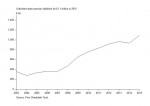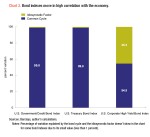Economy
Earnings growth is critical to further gains in the labor market.
While real GDP growth slowed to just a 0.7 percent annual pace as last year ended, job creation accelerated. U.S. payrolls added an average of 284,000 jobs in each of the last three months of 2015, well above the monthly average of 174,000 for the previous quarter. In addition, the jobless rate fell to 5 percent in October and remained at that rate through December, while total employment climbed to an all-time high 143.2 million workers by year-end. With such a sharp divergence between the weakening overall economy as measured by GDP and the rising strength in the labor market measured by strong job growth, a key factor in assessing the economic outlook may be fourth-quarter corporate earnings.
Stock prices can be thought of as the present value of expected future earnings. Those projected earnings take into account the outlook for sales, profit margins, risks or uncertainty related to forecasts of future earnings, and inflation, among other things. Quarterly earnings reported by U.S. public companies offer a chance to reevaluate expectations and add to our understanding of the economic environment.
A virtuous cycle between earnings and jobs is evident in the data (Chart 2) and supported by theory. As companies experience strong, consistent profit growth, confidence in the outlook for future sales and earnings improves, supporting hiring increases. However, the reverse can also be true. Should sales and earnings growth slow or decline, companies can lose confidence in the outlook and often reduce hiring and increase job cuts.
As noted earlier, continued growth in private domestic demand will be critical to the overall outlook. It will also be important for future job gains in those sectors, helping to offset weakness in export-related areas of the economy and industries affected by energy and commodity prices. Prolonged weakness in demand, especially in an environment of slowing global growth, could raise the risk of recession.
Click here to receive email notifications when the latest Business Conditions Monthly is available.
Economic outlook
The ongoing inconsistent economic performance and mixed data continue to be reflected in our Business-Conditions Cycle model. In our latest evaluation, 54 percent of our leading indicators were on an upward trend in January, unchanged from our December reading. January marks the 77th consecutive month at or above 50 percent. Consistent readings above the midpoint suggest a low probability of recession over the next six to 12 months. Conversely, a drop below 50 percent may indicate an increased chance of a future contraction.
Among the Leaders, strong favorable trends continued for real new orders for consumer goods, housing permits, retail sales, and the yield curve, supporting our analysis that the U.S. consumer is leading the economy forward.
On the negative side, the ratio of manufacturers’ sales to inventories, real new orders for core capital goods, and debit balances in margin accounts at broker/dealers were showing weak trends. The poor performance by core capital goods likely reflects the impact of energy and commodity price declines (see Chart 1, January 2016 BCM, https://www.aier.org/bcmoverview2016jan).
With a reading close to but still above 50, the model confirms our view that the U.S. is on a sustainable, moderate growth path. However, the outlook remains fragile given the strong crosscurrents affecting various parts of the economy.
The percentage of expanding coincident indicators fell to 67 from 75 percent in January. The proportion of lagging indicators expanding fell to 92 percent following a perfect 100 reading in December (Chart 3).
Click for interactive Indicators at a Glance (on mobile device turn to landscape)
Next/Previous Section:
1.Overview
2. Economy
3. Inflation
4. Policy
5. Investing
6. Pulling It All Together/Appendix



